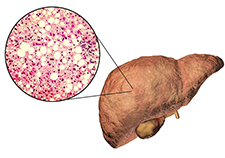Office of Research & Development |
 |
Office of Research & Development |
 |


Testosterone therapy is used mostly by aging men with low testosterone levels but is exploited by others looking to stop the normal testosterone decline that’s part of male aging. (Photo for illustrative purposes only. © Getty Images/Nastasic).
October 13, 2022
By Mike Richman
VA Research Communications
"This could mean that men in some ways could derive benefit from T therapy even if their T level is not as low as defined by the Endocrine Society."
A new study finds that an increase in the male hormone testosterone helps to improve body composition, even in men with testosterone levels near the lower end of normal.
The researchers also concluded that testosterone may benefit men from a metabolic standpoint.
The results appeared in Frontiers in Endocrinology in July 2022.

Dr. Reina Villareal, an endocrinologist at the Michael E. DeBakey VA, led the study.
Dr. Reina Villareal, an endocrinologist at the Michael E. DeBakey VA Medical Center in Houston and a professor at the nearby Baylor College of Medicine, led the study. She, first author Dr. Fnu Deepika, and their colleagues aimed to determine if there are differences in changes in body composition, metabolic profile, and bone turnover markers and bone mineral density in response to testosterone (T) therapy. Bone mineral density is a measure of the thickness of bones, and bone turnover is the process of resorption followed by replacement by new bone with little change in shape.
Regarding the significance of the findings, Villareal says, “This could mean that men in some ways could derive benefit from T therapy even if their T level is not as low as defined by the Endocrine Society,” whose guideline for low T is less than 264 nanograms per deciliter (ng/dL).
However, “I am not advocating to treat anyone with normal T levels for those benefits because of the serious side effects associated with T therapy, such as an increase in cardiovascular issues, blood clots, and prostate enlargement,” she says. “There is an ongoing randomized placebo-controlled study with over 5,000 men that is addressing the cardiovascular and prostate safety of T replacement therapy. That will likely confirm or dispute the safety concerns of T replacement therapy.”

MVP study offers new insights on genetic risk for non-alcoholic fatty liver disease

Lab studies seek hormone-based obesity treatment

One-two punch helps Veterans with weight loss
Testosterone therapy is a billion-dollar industry, with studies reaching myriad conclusions on the pros and cons of the treatment. It’s used mostly by aging men with low testosterone levels—a condition called hypogonadism—but is exploited by others looking to stop the normal testosterone decline that’s part of male aging and, in a sense, to relive their youth. Testosterone is a key male hormone that affects sex drive, bone mass, the production of red blood cells, and muscle size and strength.
In addition to older men, about 35% of men older than 45 and up to 50% of men with obesity or type 2 diabetes have low T levels, according to the Endocrine Society.
Plus, although not approved for obesity, testosterone therapy is becoming more popular as a possible option to deal with obesity in men. Usually, T therapy doesn’t produce a change in body weight. But a redistribution in body composition involves an increase in lean or muscle mass and a reduction in body fat.
The basis for Villareal’s study was the finding from another study that bone mineral density (BMD) response to testosterone therapy in men with low T levels is influenced by baseline T levels. That study showed that a baseline T level of less than 200 ng/dL is linked to greater increases in spine BMD. A BMD test helps clinicians detect osteoporosis and predict risk for bone fractures.
Villareal and her colleagues set out to learn if body composition and metabolic response varies according to baseline T levels. Research has shown that these outcomes can be improved with testosterone therapy, but it’s unclear if response would vary according to baseline T levels.
The study consisted of 105 male Veterans, ages 40 to 74, with low testosterone levels. It was carried out from 2011 to 2016 at the Michael E. DeBakey VA and the New Mexico VA Health Care System. The authors described it as the first study to evaluate whether the effects of testosterone therapy on body composition, metabolic profile, and bone turnover markers are influenced by baseline T levels.
The researchers looked at testosterone replacement therapy for men with low T, defined as less than 300 ng/dL, the Endocrine Society’s guideline until 2018. That year, its guideline was changed to less than 264 ng/dL. However, since the study was conducted before that change, some of the men who participated would have normal testosterone levels based on the new criteria.
Therapy consisted of injecting 200 milligrams every two weeks of testosterone cypionate (trade name Depo-Testosterone), an androgen and anabolic steroid used mainly to treat low T levels in men. The dose was later adjusted to a blood level of 500 to 800 ng/dL, then 300 to 600 ng/dL after the third year of the study upon the direction of the FDA. Side effects from the drug, including nausea, vomiting, and headache, were no different from what has been previously reported.
Villareal and her team found that men, regardless of their baseline testosterone level, benefited to some extent from T therapy. For instance, men with levels less than 264 ng/dL showed a greater increase at 18 months in total fat-free mass, which is mostly lean muscle mass, compared with those higher than 264 ng/dL.
Contrary to the study hypothesis, men with T levels above 264 ng/dL appeared to experience greater benefit from a metabolic standpoint, including a reduction in Hemoglobin A1c (HbA1c), a diabetes marker, along with a decline in blood glucose levels, which rise in people with diabetes and LDL (bad cholesterol). A decrease in leptin, supposedly an appetite suppressant, was due mostly to a drop in fat mass, which produces leptin. But that should not be construed as a negative effect of T therapy, according to Villareal.
“We found that surprising,” she says. “Our original hypothesis was that response in these parameters will be better for those with lower testosterone levels. That did not happen, suggesting that those with normal T by the current guidelines will benefit from the drug.”
However, the researchers cautioned against using testosterone to improve metabolic levels: “Although prior studies have suggested improvement in insulin sensitivity in men with low T, a recommendation to give T to improve the metabolic profile remains controversial. Our findings support the partial metabolic benefit from T among men with levels of more than 264 ng/dL who, by current guidelines, will not be treated with T. Therefore, the information presented in the manuscript could be valuable for both clinicians and patients in shared decision-making.”
Regarding the differences in the findings based on testosterone levels, “We surmise that the better response in fat-free mass in those with lower T levels could be due to greater sensitivity of the muscle to testosterone replacement than those with higher levels,” Villareal says. “However, one should not forget that those with higher levels had an increase in fat-free mass, as well, only to a lesser extent compared to those with lower T levels.
“On the other hand,” she adds, “the better metabolic response among those with higher T levels is hard to explain, except that maybe the group with less than 264 ng/dL needed more time on adequate T levels to see a significant improvement in blood sugar and other metabolic factors such as cholesterol. We are working on clarifying the reason for this finding in a lab” at the Michael E. DeBakey VA.
There, Villareal and her team are pursuing a VA-funded study looking at the impact of T therapy on men who have diabetes and low testosterone levels. The researchers are also examining changes in bone structure and strength.
“We hope to reach a conclusion for our findings from this cohort down the road,” she says.
She and her team are interested in other outcomes, as well, noting that evidence is emerging of a link between bone metabolism and glucose metabolism, or diabetes control.
“Hence, any change in bone metabolism brought about by T therapy may also be accompanied by changes in glucose metabolism,” she notes. “Since we are also assessing all the metabolic parameters in this study, broadly, we would like to explore if changes in bone parameters associated with T therapy will correlate with changes in metabolic parameters.
“We’ll know more as time goes on.”
VA Research Currents archives || Sign up for VA Research updates